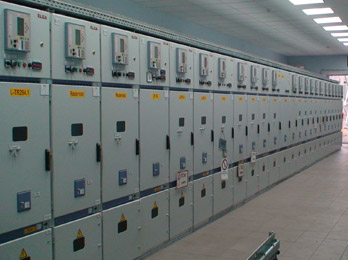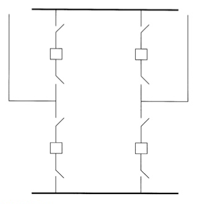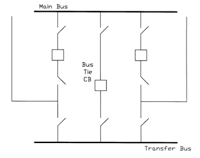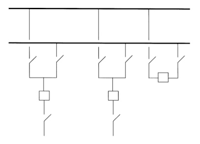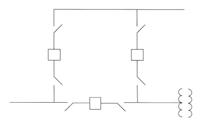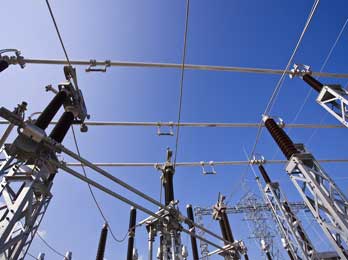
Current Switching with High Voltage Air Disconnector
In the paper are presented results of switching overvoltages investigations, produced by operations of air disconnector rated voltage 220 kV. Measurements of these switching overvoltages are performed in the air-insulated substation HPP Grabovica on River Neretva, which is an important object for operation of electric power system of Bosnia and Herzegovina.
Investigations of operating of air disconnector type Centre-Break were performed in order to determine switching overvoltage levels that can lead to relay tripping in HPP Grabovica. During operations of disconnector (synchronization or disconnecting of generator from network) malfunctions of signalling devices and burning of supply units of protection relays were appeared. Also, results of computer simulations using EMTP-ATP [1] are presented.
I. INTRODUCTION
Switching operation in power stations and substations, highvoltage faults and lightning cause high levels of high frequency overvoltages that can be coupled with low voltage secondary circuits and electronic equipment unless they are suitably protected. The function of high-voltage air-break disconnectors is to provide electrical isolation of one part of the switchgear.
Disconnector’s standards define a negligible current interrupting capability (≤0.5 A) or a voltage between the contacts if it is not significantly changed. These values of currents include the capacitive charging currents of bushing, bus bars, connectors, very short lengths of cables and the current of voltage instrument transformers. Disconnector’s contacts in air-insulated substations (AIS) are moving slowly causing numerous strikes and restrikes between contacts.
When the contacts are closed, the capacitive charging current flowing through the contacts ranges from 0.017×10-3 to 1.1×10-3 A/m for voltage levels 72.5 – 500 kV [2], depending on the rated voltage and length of bus, which is switched.
Strikes and restrikes occur as soon as the dielectric strength of the air between contacts is exceeded by overvoltage. The distance between contacts, the contacts geometry and relative atmospheric condition defines the overvoltage at the instant of strike. Every strike causes high-frequency currents tending to equalize potentials at the contacts. When the current is interrupted, the voltages at the source side and the loading side will oscillate independently. The source side will follow the power frequency while the loading side will remain at the trapped voltage. As soon as the voltage between contacts exceeds the dielectric strength of the air, at that distance the restrike will occur, and so on. Successive strikes occurring during the closing and opening operations of the off-loaded bus by the disconnector are shown in Fig. 1 a and b, respectively.
When closing takes place, the first strike will occur at the maximum value of the source voltage. Its values can be positive or negative. As the time passes a series of successive strikes will keep occurring at reduced amplitude, until the contacts touch. The highest transient overvoltage therefore occurs during the initial pre-arc, Fig.1 a. When the disconnector opening, restrikes occur because of the very small initial clearance between the contacts. At the transient beginning, the intervals between particular strikes are on the order of a millisecond, while just before the last strike; the period can reach about one half of cycle at power frequency, Fig. 1 b.

Fig. 1. The voltage due to the disconnector switching a) Disconnector closing, b) Disconnector opening 1-source side voltage, 2- load side voltage
During the switching time of operations of disconnectors at HPP Grabovica up to 500 restrikes were registered. In paper [3] there are up to 5000 restrike registered during switching operation of the disconnector. The maximum value of voltages and maximum value of the wave front increasing will take place at the maximum distance between contacts. For the purpose of the investigation of the insulation strength and induction of electromagnetic interferences (EMI), the most important are the first few strikes during the closing operation or the last few strikes during the opening operation. Each individual strike causes a travelling wave with the basic frequency on the order 0.5 MHz (330 kHz-600 kHz). Very fast transient overvoltage due to the closing operation of the disconnector at the load side of the test circuit is shown in Fig.2.

Fig. 2. Very fast transient overvoltage due to the closing operation Channel 1- source side voltage Channel 2-load side voltage
These high-frequency phenomena are coupled with the secondary circuits as a result of various mechanisms. The strongest interference is exerted by the stray capacities between the high-voltage conductors and the grounding system, followed by the metallic link between the grounding system and the secondary circuits.
High-frequency transient current flowing in the grounding system generates potential differences, every time when a strike occurs between disconnector’s contacts. In large secondary circuits, the potential differences are in the form of longitudinal voltages between the equipment inputs and the equipment enclosures.
Depending on the type of secondary circuits used and the way they are laid, differential voltages may also occur. Such a coupling mechanism has a special effect on the secondary circuits of instrument transformers, and particularly on the connected instruments, since these circuits are always galvanically linked to the grounding system. Another factor, which cannot be discounted, is the linking of these circuits to the primary plant via the internal capacities of the instrument transformers [4].
Interference levels in secondary circuits of air-insulated substations during switching disconnectors depend on following parameters:
- The transient voltages and currents generated by the switching operation;
- The voltage level of the substation;
- The relative position of the source of disturbances and susceptor;
- The nature of the grounding network;
- The cable type (shielded or unshielded);
- The way the shields are grounded.
There are two main modes of coupling secondary circuits with primary circuits [3, 5]:
- Electromagnetic or EM coupling, which can be split into three sub-categories; inductive, capacitive and radiative. The most important source of EM coupling is the propagating current and voltage waves on bus bars and power lines during high-voltage switching operations by disconnectors;
- Common impedance coupling, as a result of coupling caused by the sharing of a lumped impedance common to both the source and susceptor circuits.
Common mode voltages, i.e., voltages measured between conductors and local ground, represent the main parameter used for assessing equipment immunity. The difficulty of comparing data comes from the fact that different authors performed measurements at different places (some measurements were made at the closest point to the disconnector being operated whereas others made measurements in the vicinity of the auxiliary equipment, i.e. in the relay room). Little information is available about the grounding practice of the neutral conductor in CT or VT circuits, the quality and grounding of the sable shields as well as how the measurements have been performed. Therefore, the measured levels have to be analyzed very carefully before comparison and drawing any conclusions [5]. Results of up to date measured common mode voltages at secondary circuits of CVT, CT and VT are presented in the paper [5]. There are maximum levels of the common mode voltages ranging from 100 Vpeak up to 2.5 kVpeak in the shields of the secondary circuits cables of the CT and VT. Results show that measured values of the common mode voltages at CT/CV secondary circuits, 220 kV ratings, range from Ucm=0.32 kVpeak [6] up to Ucm=0.85 kVpeak [7].
Results shown in paper [3] are for measured common mode voltages from 3-4 kV during switching operation by disconnector in 150 kV switchgear up to 6-10 kV at 400 kV switchgear.
II. RESULTS OF EXPERIMENTAL MEASUREMENTS ON SITE
The last ten years of extensive analysis of disconnector and circuit breakers generated EMI measurements that have confirmed that disconnector operation with off-loaded busbar is the most important and typical source of interference in secondary circuits of substations. Measurements of switching overvoltages generated during disconnector operation in the air insulated substation HPP Grabovica on the river Neretva were performed. HPP Grabovica is an important object for operating of electric power system of Bosnia and Herzegovina. Investigations of operating of air disconnector type Centre-Break were performed in order to determine switching overvoltage levels that can lead to relay tripping in HPP Grabovica [8].
During operations of disconnector (synchronization or disconnecting of generator from network) malfunctions of signalling devices and burning of supply units of protection relays were appeared. Malfunctioning of auxiliary circuits were manifested by tripping relay of differential protection of the generator, phase ’4′- signalization on relay box ‘ZB I‘ and signalling ‘fire’ in 35 kV control panel.
At the same time sparking between primary terminals of the current transformer (CT) was occurred. Malfunctioning of
signalling circuits were lower (not eliminated) with installing shielded cables. Also, independent of switching operation of air insulated disconnectors, during synchronization of generator AG1 on network, it’s happened that one of the pole of 220 kV circuit breaker failures. In this case generator AG1 worked in motor regime. Because of that, HPP Grabovica plans to install circuit breakers on generator’s voltage (10,5 kV) [9].
The field tests were performed at the test circuit at HPP Grabovica, Fig. 3.
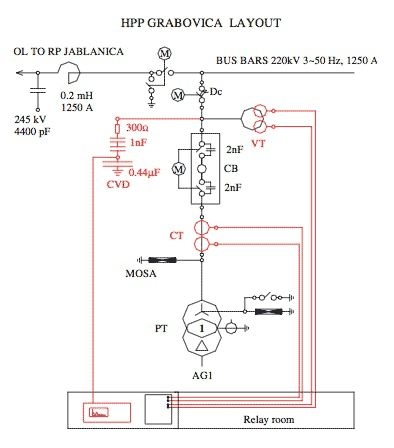
Fig. 3. The considered test circuit VT-voltage transformer (220/√3/0.1/√3/0.1/√3 kV), CT-current transformer (200/1/1 A), CVD-capacitive voltage divider, CB-circuit breaker with two interrupting chambers and parallel capacitors (SF6 220 kV, 1600 A), Dc- disconnector (220 kV, 1250 A), MOSA-metal oxide surge arrester (Ur=199,5 kV, 10 kA), PT-power transformer (64 MVA, 242/10,5±5% kV, YD5), AG1- generator 1 (64 MVA, 10,5±5% kV)
The recorded wave shape of the overvoltage at the load side is shown in Fig. 4. The overvoltage factors at busbar, k, were recorded up to 1.16 p.u. with the dominant frequency of considered transient fd equal to 0.536 MHz. Common mode voltages, Ucm, at VT were up to 708 Vpeak, with dominant frequency equal to 1.31 MHz.
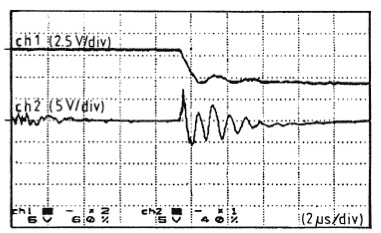
Fig. 4. Waveshape of the overvoltage Channel 1-voltage at CVD; ch 1 (2.5 V/div), probe 1x100, ratio 455 Channel 2-voltages at secondary of VT; ch 2 (5 V/div), probe 1x100
III. MODELING OF THE TEST CIRCUIT
Computer simulations were performed on the model of test circuit containing elements drawn in Fig. 5. Overvoltages at busbars were calculated during disconnector closing operations, for the same substation layout on which measurements were carried out.
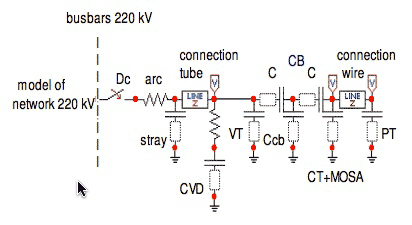
Fig. 5. Model of the test circuit Arc-4 Ω; stray-200 pF; connection tube Z=370 Ω; CVD-R=300 Ω, C=1 nF; VT-500 pF; CB-2 capacitors, each C≅2 nF, (capacitance of open contacts, each C≅20 pF), Ccb=100 pF; CT-500 pF; MOSA-100 pF; connection wire Z=440 Ω; PT-3.5 nF
The waveshape of simulated overvoltage surge at load side is given in Fig. 6. The difference between magnitudes of measured and simulated overvoltages is 5 %. The dominant frequency of simulated overvoltage is 0.620 MHz. Comparison between results of measured and calculated overvoltages certified a good agreement of obtained values.
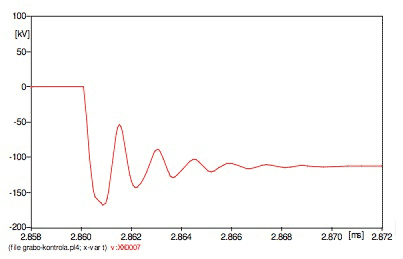
Fig. 6. Waveshape of simulated overvoltage surge
When the Capacitive Voltage Divider (CVD) was excluded, there were higher values of calculated overvoltages (15% higher on amplitude and 6 % on frequency). Capacitive divider due to primary resistor equal to 300 W and primary capacitance equal to 1 nF influences on overvoltage at the same measurement point causing attenuation and damping of transient overvoltrages. In order to reduce EMI in secondary circuits the best way is to reduce sources of interference emission during switching of air insulated disconnector.
One of the ways of reducing is to install disconnecting circuit breakers. Substation disconnectors isolate circuit breakers from rest of the system during maintenance and repair. The maintenance requirements for modern SF6 high voltage circuit breakers are lower than maintenance demands made on disconnectors, which means one of reasons for disconnectors removed. Installing disconnecting circuit breaker there are no needs for switching operation of disconnectors. With disconnecting circuit breakers it is still possible to isolate the line, but low maintenance requirements means it is no longer necessary to isolate the circuit breaker. The disconnecting breaker had to be designed to safety lock in the open position, and to meet all voltage withstanding capabilities and safety requirements of disconnectors.
Another way of reducing sources of interference emission is to install circuit breaker without parallel capacitors to contacts. This suggestion is based on analyses performed on three circuit models:
- Model of CB with two breaking chambers and paralel capacitors and VT on netvork side of CB;
- Model of CB with two breaking chambers and without paralel capacitors and VT on netvork side of CB
- Model of CB with two breaking chambers and without paralel capacitors and VT on generator side of CB
Magnitudes of simulated overvoltages are presented in Table I. Voltages are measured in point of connection of VT, CT and PT.
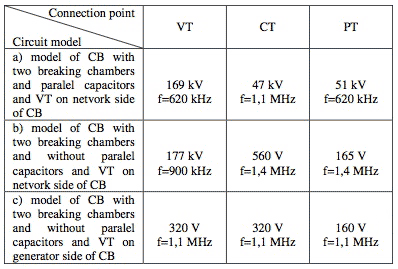
TABLE I - MAGNITUDES OF SIMULATED OVERVOLTAGES
Overvoltages on generator side of 220 kV CB during switching of disconnectors could be up to 320 V in the case of installing instrument voltage transformer (VT) on generator side of CB without parallel capacitors (near instrument current transformer CT). This case causes installing of circuit breaker at generator’s voltage (10,5 kV) for synchronization of generator to network (better conditions for synchronization). This solution of installing circuit breakers on generator’s voltage resulted from problems have occurred during synchronization of generatror with current 220 kV CB.
IV. CONCLUSION
Switching overvoltages due to disconnector operations have been analysed on the existing 220 kV AIS on HPP Grabovica. Measurements and calculations were conducted on the characteristic points in AIS, in order to determine the level of the EMI.
The result of measurements has shown that high frequency voltages on busbars occur with amplitudes up to 1.16 p.u. (233 kVpeak) and the dominant frequencies up to 0.6 MHz. The difference between magnitudes of measured and calculated overvoltages is 5 % and 15.6 % on frequency. Measured common mode voltages at secondary circuits were from 430 V up to 708 V. CVD influences on overvoltages at the same measurement point on busbars causing attenuation and damping of transient overvoltages.
Comparison of the transient computer simulations with field measurements showed that calculations could be used for
assessment of the transient overvoltages due to disconnector switching. In order to reduce EMI in secondary circuits, it is suggested to install switching modules and disconnecting circuit breakers [10] or to install circuit breakers without parallel capacitors to contacts.
AUTHORS: Salih Carsimamovic, Zijad Bajramovic, Miroslav Ljevak, Meludin Veledar, Nijaz Halilhodzic
.
Related articles
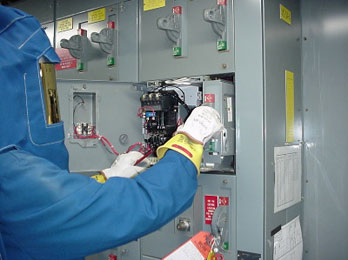
Maintenance Of Molded Case Circuit Breakers (MCCB)
The maintenance of circuit breakers deserves special consideration because of their importance for routine switching and for protection of other equipment.
Electric transmission system breakups and equipment destruction can occur if a circuit breaker fails to operate because of a lack of preventive maintenance.
The need for maintenance of circuit breakers is often not obvious as circuit breakers may remain idle, either open or closed, for long periods of time. Breakers that remain idle for 6 months or more should be made to open and close several times in succession to verify proper operation and remove any accumulation of dust or foreign material on moving parts and contacts.
Frequency Of Maintenance
Molded case circuit breakers are designed to require little or no routine maintenance throughout their normal life time. Therefore, the need for preventive maintenance will vary depending on operating conditions. As an accumulation of dust on the latch surfaces may affect the operation of the breaker, molded case circuit breakers should be exercised at least once per year.
Routine trip testing should be performed every 3 to 5 years.
Routine Maintenance Tests
Routine maintenance tests enable personnel to determine if breakers are able to perform their basic circuit protective functions. The following tests may be performed during routine maintenance and are aimed at assuring that the breakers are functionally operable. The following tests are to be made only on breakers and equipment that are deenergized.
Insulation Resistance Test
A megohmmeter may be used to make tests between phases of opposite polarity and from current-carrying parts of the circuit breaker to ground. A test should also be made between the line and load terminals with the breaker in the open position. Load and line conductors should be dis connected from the breaker under insulation resistance tests to prevent test mesurements from also showing resistance of the attached circuit.
Resistance values below 1 megohm are considered unsafe and the breaker should be inspected for pos sible contamination on its surfaces.
Milivolt Drop Test
A millivolt drop test can disclose several abnor mal conditions inside a breaker such as eroded contacts, contaminated contacts, or loose internal connec tions. The millivolt drop test should be made at a nominal direct-current volt age at 50 amperes or 100 amperes for large breakers, and at or below rating for smaller breakers. The millivolt drop is compared against manufacturer’s data for the breaker being tested.
Connections Test
The connections to the circuit breaker should be inspected to determine that a good joint is present and that overheating is not occurring. If overheating is indi cated by discoloration or signs of arcing, the connections should be re moved and the connecting surfaces cleaned.
Overload tripping test
The proper action of the overload tripping components of the circuit breaker can be verified by applying 300 percent of the breaker rated continuous current to each pole. The significant part of this test is the automatic opening of the circuit breaker and not tripping times as these can be greatly affected by ambient conditions and test condi tions.
Mechanical operation
The mechanical operation of the breaker should be checked by turning the breaker on and off several times.
SOURCE: HYDROELECTRIC RESEARCH AND TECHNICAL SERVICES GROUP
.
Related articles
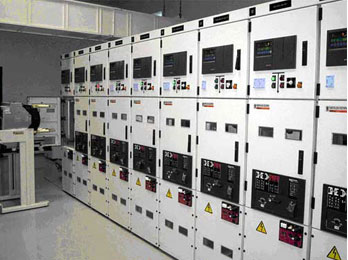
What CB to use? Vacuum or SF6 circuit breaker?
Until recently oil circuit breakers were used in large numbers for Medium voltage Distribution system in many medium voltage switchgears. There are number of disadvantages of using oil as quenching media in circuit breakers. Flammability and high maintenance cost are two such disadvantages! Manufacturers and Users were forced to search for different medium of quenching. Air blast and Magnetic air circuit breakers were developed but could not sustain in the market due to other disadvantages associated with such circuit breakers. These new types of breakers are bulky and cumbersome. Further research were done and simultaneously two types of breakers were developed with SF6 as quenching media in one type and Vacuum as quenching media in the other. These two new types of breakgasers will ultimately replace the other previous types completely shortly. There are a few disadvantages in this type of breakers also. One major problem is that the user of the breakers are biased in favour of old fashioned oil circuit breakers and many of the users always have a step motherly attitude to the new generations of the breakers. However in due course of time this attitude will disappear and the new type of breakers will get its acceptance among the users and ultimately they will completely replace the oil circuit breakers. An attempt is made to make a comparison between the SF6 type and vacuum type circuit breakers with a view to find out as to which of the two types is superior to the other. We will now study in detail each type separately before we compare them directly.
Vacuum Circuit Breaker
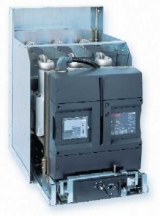
Evolis MV Circuit Breaker
In a Vacuum circuit breaker, vacuum interrupters are used for breaking and making load and fault currents. When the contacts in vacuum interrupter separate, the current to be interrupted initiates a metal vapour arc discharge and flows through the plasma until the next current zero. The arc is then extinguished and the conductive metal vapour condenses on the metal surfaces within a matter of micro seconds. As a result the dielectric strength in the breaker builds up very rapidly.
The properties of a vacuum interrupter depend largely on the material and form of the contacts. Over the period of their development, various types of contact material have been used. At the moment it is accepted that an oxygen free copper chromium alloy is the best material for High voltage circuit breaker. In this alloy , chromium is distributed through copper in the form of fine grains. This material combines good arc extinguishing characteristic with a reduced tendency to contact welding and low chopping current when switching inductive current. The use of this special material is that the current chopping is limited to 4 to 5 Amps.
At current under 10KA, the Vacuum arc burns as a diffuse discharge. At high values of current the arc changes to a constricted form with an anode spot. A constricted arc that remain on one spot for too long can thermically over stress the contacts to such a degree that the deionization of the contact zone at current zero can no longer be guaranteed . To overcome this problem the arc root must be made to move over the contact surface. In order to achieve this, contacts are so shaped that the current flow through them results in a magnetic field being established which is at right angles to the arc axis. This radial field causes the arc root to rotate rapidly around the contact resulting in a uniform distribution of the heat over its surface. Contacts of this type are called radial magnetic field electrodes and they are used in the majority of circuit breakers for medium voltage application.
A new design has come in Vacuum interrupter, in which switching over the arc from diffusion to constricted state by subjecting the arc to an axial magnetic field. Such a field can be provided by leading the arc current through a coil suitably arranged outside the vacuum chamber. Alternatively the field can be provided by designing the contact to give the required contact path. Such contacts are called axial magnetic field electrodes. This principle has advantages when the short circuit current is in excess of 31.5 KA.
SF6 Gas Circuit Breaker
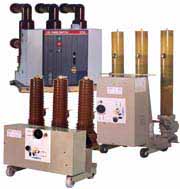
SF6 circuit breakers
In an SF6 circuit-breaker, the current continues to flow after contact separation through the arc whose plasma consists of ionized SF6 gas. For, as long as it is burning, the arc is subjected to a constant flow of gas which extracts heat from it. The arc is extinguished at a current zero, when the heat is extracted by the falling current. The continuing flow of gas finally de-ionises the contact gap and establishes the dielectric strength required to prevent a re-strike.
The direction of the gas flow, i.e., whether it is parallel to or across the axis of the arc, has a decisive influence on the efficiency of the arc interruption process. Research has shown that an axial flow of gas creates a turbulence which causes an intensive and continuous interaction between the gas and the plasma as the current approaches zero. Cross-gas-flow cooling of the arc is generally achieved in practice by making the arc move in the stationary gas. This interruption process can however, lead to arc instability and resulting great fluctuations in the interrupting capability of the circuit breaker.
In order to achieve a flow of gas axially to the arc a pressure differential must be created along the arc. The first generation of the SF6 circuit breakers used the two-pressure principle of the air-blast circuit-breaker. Here a certain quantity of gas was kept stored at a high pressure and released into the arcing chamber. At the moment high pressure gas and the associated compressor was eliminated by the second generation design. Here the pressure differential was created by a piston attached to the moving contacts which compresses the gas in a small cylinder as the contact opens. A disadvantage is that this puffer system requires a relatively powerful operating mechanism.
Neither of the two types of circuit breakers described was able to compete with the oil circuit breakers price wise. A major cost component of the puffer circuit-breaker is the operating mechanism; consequently developments followed which were aimed at reducing or eliminating this additional cost factor. These developments concentrated on employing the arc energy itself to create directly the pressure-differential needed. This research led to the development of the self-pressuring circuit-breaker in which the over – pressure is created by using the arc energy to heat the gas under controlled conditions. During the initial stages of development, an auxiliary piston was included in the interrupting mechanism, in order to ensure the satisfactory breaking of small currents. Subsequent improvements in this technology have eliminated this requirement and in the latest designs the operating mechanism must only provide the energy needed to move the contacts.
Parallel to the development of the self-pressuring design, other work resulted in the rotating – arc SF6 gas circuit breaker. In this design the arc is caused to move through, in effect the stationery gas. The relative movement between the arc and the gas is no longer axial but radial, i.e., it is a cross-flow mechanism. The operating energy required by circuit breakers of this design is also minimal.
Table 1. Characteristics of the SF6 and vacuum current interrupting technologies.
| SF6 Circuit Breakers | Vacuum Circuit Breakers | ||
| Criteria | Puffer Circuit Breaker | Self-pressuring circuit-breaker | Contact material-Chrome-Copper |
| Operating energy requirements | Operating Energy requirements are high, because the mechanism must supply the energy needed to compress the gas. | Operating Energy requirements are low, because the mechanism must move only relatively small masses at moderate speed, over short distances. The mechanism does not have to provide the energy to create the gas flow | Operating energy requirements are low, because the mechanism must move only relatively small masses at moderate speed, over very short distances. |
| Arc Energy | Because of the high conductivity of the arc in the SF6 gas, the arc energy is low. (arc voltage is between 150 and 200V.) | Because of the very low voltage across the metal vapour arc, energy is very low. (Arc voltage is between 50 and 100V.) | |
| Contact Erosion | Due to the low energy the contact erosion is small. | Due to the very low arc energy, the rapid movement of the arc root over the contact and to the fact that most of the metal vapour re-condenses on the contact, contact erosion is extremely small. | |
| Arc extinguishing media | The gaseous medium SF6 possesses excellent dielectric and arc quenching properties. After arc extinction, the dissociated gas molecules recombine almost completely to reform SF6. This means that practically no loss/consumption of the quenching medium occurs. The gas pressure can be very simply and permanently supervised. This function is not needed where the interrupters are sealed for life. | No additional extinguishing medium is required. A vacuum at a pressure of 10-7 bar or less is an almost ideal extinguishing medium. The interrupters are ‘sealed for life’ so that supervision of the vacuum is not required. | |
| Switching behavior in relation to current chopping | The pressure build-up and therefore the flow of gas is independent of the value of the current. Large or small currents are cooled with the same intensity. Only small values of high frequency, transient currents, if any, will be interrupted. The de-ionization of the contact gap proceeds very rapidly, due to the electro-negative characteristic of the SF6 gas and the arc products. | The pressure build-up and therefore the flow of gas is dependent upon the value of the current to be interrupted. Large currents are cooled intensely, small currents gently. High frequency transient currents will not, in general, be interrupted. The de-ionization of the contact gap proceeds very rapidly due to the electro-negative characteristic of the SF6 gas and the products. | No flow of an ‘extinguishing’ medium needed to extinguish the vacuum arc. An extremely rapid de-ionization of the contact gap, ensures the interruption of all currents whether large or small. High frequency transient currents can be interrupted. The value of the chopped current is determined by the type of contact material used. The presence of chrome in the contact alloy with vacuum also. |
| No. of short-circuit operation | 10—50 | 10—50 | 30—100 |
| No. full load operation | 5000—10000 | 5000—10000 | 10000—20000 |
| No. of mechanical operation | 5000—20000 | 5000—20000 | 10000—30000 |
Comparison of the SF6 And Vacuum Technologies
The most important characteristics of the SF6 gas and vacuum-circuit breakers, i.e., of SF6 gas and vacuum as arc-extinguishing media are summarized in Table-1.
In the case of the SF6 circuit-breaker, interrupters which have reached the limiting number of operations can be overhauled and restored to ‘as new’ condition. However, practical experience has shown that under normal service conditions the SF6 interrupter never requires servicing throughout its lifetime. For this reason, some manufacturers no longer provide facilities for the user to overhaul the circuit-breaker, but have adopted a ‘sealed for life’ design as for the vacuum-circuit breaker.
The operating mechanisms of all types of circuit-breakers require servicing, some more frequently than others depending mainly on the amount of energy they have to provide. For the vacuum-circuit breaker the service interval lies between 10,000 and 20,000 operations. For the SF6 designs the value varies between 5,000 and 20,000 whereby, the lower value applies to the puffer circuit-breaker for whose operation, the mechanism must deliver much more energy.
The actual maintenance requirements of the circuit-breaker depend upon its service duty, i.e. on the number of operations over a given period of time and the value of current interrupted. Based on the number of operations given in the previous section, it is obvious that SF6 and vacuum circuit-breakers used in public supply and /or industrial distribution systems will, under normal circumstances, never reach the limits of their summated breaking current value. Therefore, the need for the repair or replacement of an interrupter will be a rare exception and in this sense these circuit-breakers can be considered maintenance-free. Service or maintenance requirements are therefore restricted to routine cleaning of external surfaces and the checking and lubrication of the mechanism, including the trip-linkages and auxiliary switches. In applications which require a very high number of circuit-breaker operations e.g. for arc furnace duty or frequently over the SF6 design, due to its higher summated-breaking current capability. In such cases it is to be recommended that the estimation of circuit-breaker maintenance costs be given some consideration and that these be included in the evaluation along with the initial, capital costs.
Reliability
In practice, an aspect of the utmost importance in the choice of a circuit-breaker is reliability.
The reliability of a piece of equipment is defined by its mean time to failure (MTF), i.e. the average interval of time between failures. Today, the SF6 and vacuum circuit-breakers made use of the same operating mechanisms, so in this regard they can be considered identical.
However, in relation to their interrupters the two circuit breakers exhibit a marked difference. The number of moving parts is higher for the SF6 circuit-breaker than that for the vacuum unit. However, a reliability comparison of the two technologies on the basis of an analysis of the number of components are completely different in regards design, material and function due to the different media. Reliability is dependent upon far too many factors, amongst others, dimensioning, design, base material, manufacturing methods, testing and quality control procedures, that it can be so simply analyzed.
In the meantime, sufficient service experience is available for both types of circuit-breakers to allow a valid practical comparison to be made. A review of the available data on failure rates confirms that there is no discernible difference in reliability between the two circuit-breaker types. More over, the data shows that both technologies exhibit a very high degree of reliability under normal and abnormal conditions.
Switching of fault currents
Today, all circuit-breakers from reputable manufacturers are designed and type-tested in conformance with recognized national or international standards (IEC56). This provides the assurance that these circuit-breakers will reliably interrupt all fault currents up to their maximum rating. Further, both types of circuit-breakers are basically capable of interrupting currents with high DC components; such currents can arise when short circuits occur close to a generator. Corresponding tests have indeed shown that individual circuit-breakers of both types are in fact, capable of interrupting fault currents with missing current zeros i.e. having a DC component greater than 100 per cent. Where such application is envisaged, it is always to be recommended that the manufacturer be contacted and given the information needed for a professional opinion.
As regards the recovery voltage which appears after the interruption of a fault current the vacuum-circuit breaker can, in general, handle voltages with RRV values of up to 5KV. SF6 circuit-breakers are more limited, the values being in the range from 1 to 2 KV. In individual applications, e.g. in installations with current limiting chokes or reactors, etc., With SF6 circuit-breakers it may be advisable or necessary to take steps to reduce that rate of rise of the transient recovery voltage.
Switching small inductive currents
The term, small inductive currents is here defined as those small values of almost pure inductive currents, such as occur with unloaded transformers, motor during the starting phase or running unloaded and reactor coils. When considering the behavior of a circuit-breaker interrupting such currents, it is necessary to distinguish between high frequency and medium frequency transient phenomena.
Medium frequency transients arise from, amongst other causes, the interruption of a current before it reaches its natural zero. All circuit-breakers can, when switching currents of the order of a few hundred amperes and, due to instability in the arc, chop the current immediately prior to a current zero.
This phenomenon is termed real current chopping. When it occurs, the energy stored in the load side inductances oscillates through the system line to earth capacitances (winding and cable capacitances) and causes an increase in the voltage. This amplitude of the resulting over voltage is a function of the value of the current chopped. The smaller the chopped current, the lower the value of the over voltage.
In addition to the type of circuit – breaker, the system parameters at the point of installation are factors which determine the height of the chopping current, in particular the system capacitance parallel to the circuit breaker is of importance. The chopping current of SF6 circuit-breakers is essentially determined by the type of circuit-breaker. The value of chopping current varies from 0.5A to 15A, whereby the behavior of the self – pressuring circuit-breaker is particularly good, its chopping current being less than 3A.This ‘soft’
Switching feature is attributable to the particular characteristics of the interrupting mechanism of the self-pressuring design and to the properties of the SF6 gas itself.
In the early years of the development of the vacuum circuit-breaker the switching of small inductive currents posed a major problem, largely due to the contact material in use at that time. The introduction of the chrome copper contacts brought a reduction of the chopping current to between 2 to 5A.The possibility of impermissible over voltages arising due to current chopping has been reduced to a negligible level.
High frequency transients arise due to pre- or re-striking of the arc across the open contact gap. If, during an opening operation, the rising voltage across the opening contacts, exceed the dielectric strength of the contact gap , a re-strike occurs. The high-frequency transient current arising from such a re-strike can create high frequency current zeros causing the circuit-breaker to, interrupt again. This process can cause a further rise in voltage and further re-strikes. Such an occurrence is termed as multiple restriking.
With circuit- breakers that can interrupt high frequency transient currents, re-striking can give rise to the phenomenon of virtual current chopping. Such an occurrence is possible when a re-strike in the first-phase-to-clear, induces high frequency transients in the other two phases, which are still carrying service frequency currents. The superimposition of this high frequency oscillation on the load current can cause an apparent current zero and an interruption by the circuit-breaker, although the value of load current may be quite high. This phenomenon is called virtual current chopping and can result in a circuit breaker ‘chopping’ very much higher values of current than it would under normal conditions. The results of virtual current chopping are over-voltages of very high values.
This phenomenon is termed real current chopping. When it occurs, the energy Stored in the load side inductances oscillates through the system line to earth capacitances (winding and cable capacitances) and causes an increase in the voltage. This amplitude of the resulting over voltage is a function of the value of the current chopped. The smaller the chopped current, the lower the value of the over voltage.
In addition to the type of circuit – breaker, the system parameters at the point of installation are factors which determine the height of the chopping current, in particular the system capacitance parallel to the circuit breaker is of importance. The chopping current of SF6 circuit-breakers is essentially determined by the type of circuit-breaker. The value of chopping current varies from 0.5A to 15A, whereby the behaviour of the self – pressuring circuit-breaker is particularly good, its chopping current being less than 3A.This ‘soft’ Switching feature is attributable to the particular characteristics of the interrupting mechanism of the self-pressuring design and to the properties of the SF6 gas itself.
In the early years of the development of the vacuum circuit-breaker the switching of small inductive currents posed a major problem, largely due to the contact material in use at that time. The introduction of the chrome copper contacts brought a reduction of the chopping current to between 2 to 5A.The possibility of impermissible over voltages arising due to current chopping has been reduced to a negligible level.
High frequency transients arise due to pre- or re-striking of the arc across the open contact gap. If, during an opening operation, the rising voltage across the opening contacts exceeds the dielectric strength of the contact gap, a re-strike occurs. The high-frequency transient current arising from such a re-strike can create high frequency current zeros causing the circuit-breaker to, interrupt again. This process can cause a further rise in voltage and further re-strikes. Such an occurrence is termed as multiple re-striking.
With circuit- breakers that can interrupt high frequency transient currents, re-striking can give rise to the phenomenon of virtual current chopping. Such an occurrence is possible when a re-strike in the first-phase-to-clear, induces high frequency transients in the other two phases, which are still carrying service frequency currents. The superimposition of this high frequency oscillation on the load current can cause an apparent current zero and an interruption by the circuit-breaker, although the value of load current may be quite high. This phenomenon is called virtual current chopping and can result in a circuit breaker ‘chopping’ very much higher values of current than it would under normal conditions. The results of virtual current chopping are over-voltages of very high values
Table2. Comparison of the SF6 And Vacuum Technologies In Relation To Operational Aspects
| Criteria | SF6 Breaker | Vacuum Circuit Breaker |
| Summated current cumulative | 10-50 times rated short circuit current | 30-100 times rated short circuit current |
| Breaking current capacity of interrupter | 5000-10000 times | 10000-20000 times |
| Mechanical operating life | 5000-20000 C-O operations | 10000-30000 C-O operations |
| No operation before maintenance | 5000-20000 C-O operations | 10000-30000 C-O operations |
| Time interval between servicing Mechanism | 5-10 years | 5-10 years |
| Outlay for maintenance | Labour cost High, Material cost Low | Labour cost Low, Material cost High |
| Reliability | High | High |
| Dielectric withstand strength of the contact gap | High | Very high |
Very extensive testing has shown that, because of its special characteristics the SF6 self-pressuring circuit-breaker possesses considerable advantages in handling high frequency transient phenomena, in comparison with both the puffer type SF6 and the vacuum circuit breakers. The past few years have seen a thorough investigation of the characteristics of vacuum circuit breakers in relation to phenomena such as multiple re-striking and virtual current chopping. These investigations have shown that the vacuum circuit-breaker can indeed cause more intense re-striking and hence more acute over voltages than other types. However, these arise only in quite special switching duties such as the tripping of motors during starting and even then only with a very low statistical probability. The over-voltages which are created in such cases can be reduced to safe levels by the use of metal oxide surge diverters.
Table3. Comparison of the SF6 And Vacuum Switching Technologies In Relation To Switching Applications
| Criteria | SF6 Circuit Breaker | Vacuum Circuit Breaker |
| Switching of Short circuit current with High DC component | Well suited | Well suited |
| Switching of Short circuit current with High RRV | Well suited under certain conditions (RRV>1-2 kV per Milli seconds | Very well suited |
| Switching of transformers | Well suited. | Well suited |
| Switching of reactors | Well suited | Well suited. Steps to be taken when current <600A. to avoid over voltage due to current chopping |
| Switching of capacitors | Well suited. Re-strike free | Well suited. Re-strike free |
| Switching of capacitors back to back | Suited. In some cases current limiting reactors required to limit inrush current | Suited. In some cases current limiting reactors required to limit inrush current |
| Switching of arc furnace | Suitable for limited operation | Well suited. Steps to be taken to limit over voltage. |
.


